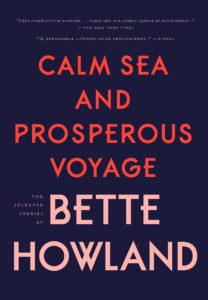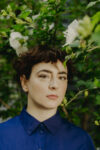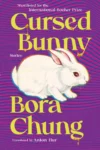Calm Sea and Prosperous Voyage’s very existence is a miracle of happenstance and (re)discovery. The (re)collection started with Brigid Hughes, editor and founder of literary magazine A Public Space, browsing the dollar carts at Housing Works Bookstore, and finding what I imagine was a mostly destroyed (or: well read) copy of Bette Howland’s memoir W-3. It’s a story that already has a kind of mythic quality to it — the bookstore becomes a hidden cave, a treasure chest — and would lead to a small epic described by Hughes: “a search for the author first led to numerous dead ends, then to her son, a cache of unpublished work, and a safe-deposit box in Tulsa, Oklahoma, with postcards and letters from a forty-year correspondence with Saul Bellow.” From there, issue 23 of APS, the “Lost Women” issue with work by writers like Kathleen Collins, Etel Adnan, and Friederike Mayrocker — and now, there is Calm Sea and Prosperous Voyage, the inaugural book of APS’s book-publishing arm, A Public Space Books.
It is difficult, of course, to separate that context from the reading experience. Especially in the collection’s first story, “A Visit,” there is the feeling that the ever-shrewd APS editors invite this difficulty right up front: a story of sudden accidental death, of the discovery one is dead after a wreck on an abandoned road. With Howland’s characteristic humor (dark) and language (evocative, dialectic), the narrator says, “I was wondering what the chances might be of undertaking a crash course in self-improvement here in Eternity. Not so hot. Not so hot.” Ambiguous, of course, but the story’s end — “The light went out. Through the dark I came up. I was looking for you, I went looking for you. My arm was still aching.” — steers the collection toward a question, if it is our arm aching waking up from the wreck to find Bette, or Bette trying to find us: What is found here in the recollection of Bette Howland?
Foremost, I think, Chicago. A very specific time (70’s/80’s) and place that is Chicago — characters feeling themselves trapped by poverty and violence in Floral Park, or by marriage, by race, gender. Of the collection’s eleven stories, six of them are explicit in their dedication to the landscape, in one the narrator saying “Let me tell you about this part of the country.” These stories are beautifully linked — a character here pops up there, a road name is recognized — such that it almost feels like living in a neighborhood and watching days go by for all the faces you recognize on the corners. Howland displays a sociological lucidity when addressing her native city, put especially on stage by the story “Twenty-Sixth and California” — the address of a courthouse. As with most of the Chicago stories, Howland is implicitly the narrator present — exhausted by family, by her love (or at least responsibility) toward them, cutting in her insights and yet warm in her descriptions — but in “Twenty-Sixth” she is all but absent except in one line: “I remember all at once that I have been a child napping on these benches myself.” And it is from this primary relationship to Place that Howland reports the cases of the day: a murder, an armed robbery — what Howland calls “violence court,” where her Chicago is a place subject to the violence of its systems projecting in- and out-ward — and the complications in each: gender complications, racial complications — “And the all-white jury. What are they supposed to make of this?” Throughout the Chicago stories Howland’s political insights rise to be part of the text: the “captive markets” of slum neighborhoods with overpriced produce; white flight; violence highlighted in news reporting on the South Side; said violence being dinner conversation, “Our fear is becoming socialized.” In one extremely prescient moment in “Twenty-Sixth” (vaguely reminiscent of Joyce, with Bloom’s definition of a Nation) Howland writes “A city isn’t just a lot of people. Or is it?”
We also find a progression through the career Howland did not really have, with the (mostly) unpublished later work found in the more sprawling stories in the collection’s back, “German Lessons” and the titular (novella, technically, maybe?) “Calm Sea and Prosperous Voyage.” Both of these stories display a frenetic emotional register that jumps from page to page, telling the stories of women left isolated but not left alone. The titular story spreads like a spill and focuses on death. The narrator is attending the funeral for a complicated genius of a man (“Brains are sexy — in men. Any woman alive has brains enough to know that.”) whose relationship with her was ambiguous at best. The story shouts into the void and demands answers.
Howland’s primary concern throughout the collection is the quotidian, and its existence as the expression of material, systemic struggle and existential, metaphysical struggle. “In other words,” she writes in “To the Country,” “it was the same old story; the old continuous struggle, the day-to-day hand-to-mouth existence.” Or, as she puts it in “Calm Sea,” “All the stories we don’t have time for.” Her characters are single mothers, noisy neighbors, students living on the cheap, heavily accented cousins, shopkeeps, beat cops — all described delicately with boundless feeling but full of holes, entrenched in failed or failing marriages, the violence of the landscape (“So they shot him seven times.”). In each relationship presented Howland asks what one owes the other; Howland is always reaching toward these grand capital-Q Questions that can easily keep one awake at night, but refuses answers outside of observation. In some ways, what we owe each other in theory is a meaningless question when we consider what we have already given or taken away — but the questions linger, and the days pile on. Howland knows she’s not finding answers, necessarily — her observations, as keen as they are, cannot find what isn’t there — but knows the questions still matter.
The questions matter because they are doozies. All Howland’s characters are lost in some way, trying to figure out the questions themselves — what does one want, what does my neighbor’s life have to do with me, what is there to be done — and reading these stories feels like a reminder that, beneath it all or above it all (the day-to-day), there is something complex and absurd about being a person in a place. Howland moves us through the complexity and the absurdity with stunning prose — not unlike that of another literary rediscovery, Lucia Berlin, in it’s terse evocativeness, perfectly paced sentences hitting brilliant notes of surprising diction — and it sometimes feels like she’s holding your hand and giving you a tour of The Grand Suffering. The stories are not bleak, necessarily — though they are by-and-large desperately unhappy — but they are true. “The air is pure and full of truth,” she writes in one story. As if answering in another she writes, “In some ways it’s too good, too rich — we are just skimming the cream.”
As are we. Calm Sea is a wonderful book but the feeling I’m left with after finishing it is much the same — it is too rich, and I am just skimming the cream. As a selected edition this is somewhat inevitable — to me it feels like the job of a selected edition to entice a reader (or, in this case, the reading public) down the rabbit hole. But, criminally, there is not much else widely available — Howland published three books in her lifetime and we can only wait to see if they will come into print again. Of course this is a criminal state of affairs — we’ve forgotten a genius.
And, actually, so many. As a “Lost Woman,” Bette Howland is in good company with new celebration. February saw Ecco publish Notes from a Black Woman’s Diary by Kathleen Collins, following the success of 2016’s Whatever Happened to Interracial Love? June will see the publication of 94-year-old Etel Adnan’s latest book on poetry from Nightboat, Time. November of last year saw the publication, for the first time in English, of Mayrocker’s Scardanelli from Song Cave. And outside of APS, Rediscovered Woman Writers have become a kind of genre with a ravenous fan base. Lit Hub dubbed 2015 “The Year of Rediscovered Women Writers” following the success of Lucia Berlin and Clarice Lispector recollections (and my dearest of heart, Violette Leduc) — and the argument could be made for every year since then, with this year’s reissue of Ann Quin from & Other Stories, new Jane Bowles reissues, Elizabeth Taylor and Eve Babitz from NYRB, Rachel Ingalls from New Directions, Helen Garner from Text, the concerted effort of Emma Garmand’s Paris Review column “Feminize Your Canon.” The list goes on, wonderfully. There is the feeling of renewed attention — some call it a trend.
Of course, it’s anything but. The renewed (read: mainstream) attention is nice, but wherever there have been passionate editors and readers there have been and will be a home for “lost” classics. Houses like Dalkey Archive, New Directions, and Peter Owen have always made shelf space for the criminally under-read; and entire presses exist in part to keep “lost” women in print, as seen at The Feminist Press (founded 1970), Virago (1973), Persephone (1999), and Dorothy (2009). There would and should be a political snafu to call the attention for these writers a trend, rightly, because the work has been being done for some time now — where were we? Reading, one would hope, yet not enough.
It feels like there is a political examination to be made over the very word “rediscovery.” What does that even mean? What are the ethics of rediscovery? These feel like important questions: Who “lost” these works in the first place, and Who is benefiting now from their being “found”? The canon is a cruel list kept upright by largely patriarchal, hegemonic (white, rich) cultural institutions that wield the power to dignify certain works as “important” and others as not — as much is clear — but the same can often be said of the publishing industry. Small presses like The Feminist Press and now A Public Space Books, and campaigns like We Need Diverse Books, are doing the Good Work of injecting much-needed life into a room of dusty dead men — and, again, there is nothing New or particularly 2015 (or 2019) about the publishing mission of publishing genius women who fall unjustifiably out of print when entire presses have been and are devoted to the mission now for nearly fifty years — but I wonder if it is (occasionally, anyway) those same rooms of dusty dead men who “lost” the work that now get to blow the rap air-horns of “rediscovery.” I’m reminded of Rabbi Jim from this Howland collection: “Remember him? The one who used to dress as Queen Esther on Purim and deliver his sermons in drag? Something about how there’s nothing wrong with being a woman, we’re really okay guys.”
These authors should be in print, and people should be reading them, and the celebration of them is justifiably loud, but I wonder where the credit for “rediscovery” is landing, and whether the “rediscovered woman writer” as a “phenomenon” will turn wheels as a commodity — in ten or twenty years, will we “rediscover” the woman authors publishing now? Will we re-”rediscover” these authors? How many times will we re-re-rediscover women like Jane Bowles or Ann Quin before their importance can be stated plainly without explanatory footnote?
For Howland, I hope, the answer is Now. Or it better be. She’s marvelous company, and has a small piece of wisdom well put in every story in Calm Sea, even here: “We must just do as best we can. / So here goes.”
Recently, I had the fortune of lunch with the kind folks at A Public Space. With the kind of brain power I can’t even hope to add much if anything to, topics flew by quickly — Regional fiction, Edith Wharton’s New York, Saul Bellow’s newest biography — but someone asked editor Brigid Hughes a question I’m hopeless to remember now but doesn’t matter as much as her answer. She said, “As with so many things these days, I turn to Bette Howland.” And I, too, find myself turning, and turning.
Kyle Francis Williams is a writer living in Brooklyn. He is a 2019 A Public Space Fellow.
This post may contain affiliate links.








